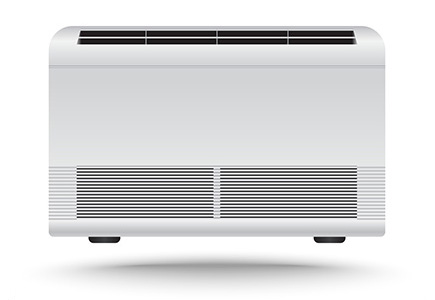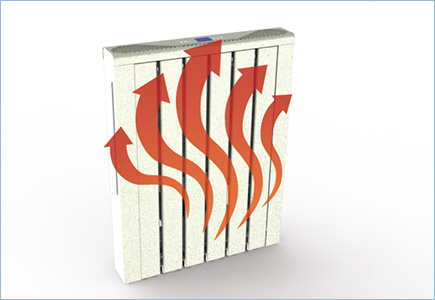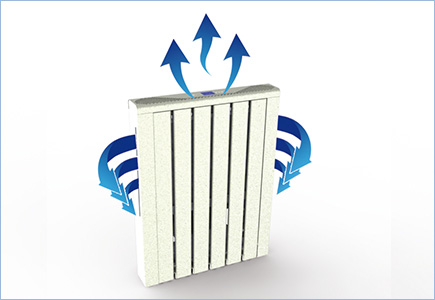KONRAD, hybrid terminals in Class A
A building with a low energy class, hence very energy-consuming, and with low environmental comfort, suffers today a commercial devaluation of even -20% per year (source: ISTAT and other national statistics).
Instead a property with a high energy class and a good air conditioning system for both winter and summer, now holds the market prices.
In almost every European country there are tax benefits or incentives to renovate old buildings and to improve energy efficiency. Many are the structural components involved: windows, insulation of walls, new boilers, heat pumps and terminals that operate at low temperature. In Italy the state contribution varies from 50% to 65%, depending on the type of intervention.
A good cladding, combined with a poor or technically obsolete air conditioning system frustrates the investment in the renovation; that’s why you should pay close attention to this aspect and not make mistakes.
Today there are many solutions on the market and each manufacturer obviously extols the characteristics of its products, playing on poor information from the users. In fact there is no perfect system, i.e. the technical solution that allows for maximum energy savings with maximum comfort and with minimal expense, as well as the saying "your cake and eat it too".
There are trade-offs that can be technical and economic and trade-offs that are closest to the needs of the end user.
The limits of the fancoils and of the radiant systems
The fancoil units have the technical limit that they must work in heating and cooling always airing, then with a fan that blows air into the environment by making some noise. There are solutions more or less pleasing from the aesthetic point of view but all require forced ventilation to operate.
The radiant systems, much praised in recent years, while they give a great acoustic comfort because they are silent as the radiators and have a great aesthetic impact, because they are not seen being installed under the floor or under the plaster of the walls or ceiling , have anyhow their technical limitations, which we try to explain here below.

The radiant system has a large thermal inertia, so a long time to get up to the set temperature, and is very slow to react to the change of the thermal load.
If you want to change the indoor conditions by operating on the thermostat either to raise the temperature or to reduce it , the system needs a long time to reach the new set point. Another limitation is that, if you use the radiant system also for summer cooling, you need to integrate it with a dehumidification unit too.
These thwarts the concept that wants the radiant system being silent because within the machine there is a compressor and fans which make some noise. On the other hand we must take into account the fact, not irrelevant to the question of the building's energy consumption, that the inclusion of this additional machine reduces the SEER, ie the overall efficiency in the cooling season, of the whole system (heat pump + distribution + dehumidifier).
Another factor to consider is that the installation of a radiant system is costly and quite invasive, even more so if it is used in renovation rather than in new houses.
Ultimately, if on the one hand the radiant system has the virtue of evenly distribute the temperature in the room, so that there will not be large differences between the measured temperature close to the floor or near the wall, this is also a limit and even a defect just because it is almost impossible to get different temperatures in the various rooms. In practice, once a comfortable temperature is set in the bedroom, usually lower, the same will be imposed in the living room too, or in the studio, where people are expected to get a few degrees more for ideal comfort.
In conclusion, from the "spending" point of view, the fan coil is the most economical solution while the radiant system is the most expensive; both systems have advantages, but also some limitations.
Is there a perfect solution?
As just said, there isn’t the ideal product, but there is a technological solution, called “hybrid”, which allows to achieve the best environmental comfort in terms of noise and heat distribution. It is the union, in practice, of two products: the traditional radiator and the fancoil.
This product is called KONRAD and is produced by the Italian company AERFOR srl.
"The advantage of the union of the two products is
to take the best from each".

The front part of the machine is the classic radiator which, being used for heating in winter, may heat without the need to ventilate and is therefore quiet as a radiator: ZERO decibels of noise.
This allows for maximum comfort in terms of low noise adding to it the beneficial effect of a radiant heating.

In the rear of the machine it is placed a heat exchanger and a very quiet fan that allows to cool in the summer and to dehumidify.
This solution enables the rapid and uniform distribution of fresh air in the rooms, without having to install to the walls unattractive air conditioners.
The terminal units KONRAD of AERFOR allow therefore to have an unparalleled low noise during operation ensuring a perfect acoustic comfort. This, combined with an efficient and rapid heat distribution is the optimal response to the need of comfort and quick adaptation to varying thermal loads.
Where to install the terminal hybrid unit KONRAD?
Konrad is designed specifically to replace traditional radiators in renovation of buildings using the spaces beside or under the windows, adding to the simple heating function also summer cooling.
Very important is the fact that Konrad is a modern solution for individual houses, where one installs in the living area , usually at the ground floor, a radiant system combined with a few units Konrad for dehumidification only and for the management of variable loads, while in the sleeping area, usually on the upper floor, the clima is ensured only by units Konrad independently managing the various rooms.
For small buildings with centralized system, both for heating and for cooling, this solution simplifies the installation and the conduction of the apartments to the owners, moreover it eases the work of the administrator of the building.
Contact us to learn more about the benefits of Konrad, the hybrid terminal unit functioning at ZERO decibels with ventilation and radiant effect.
Ivan Spagnol, Aerfor Srl





